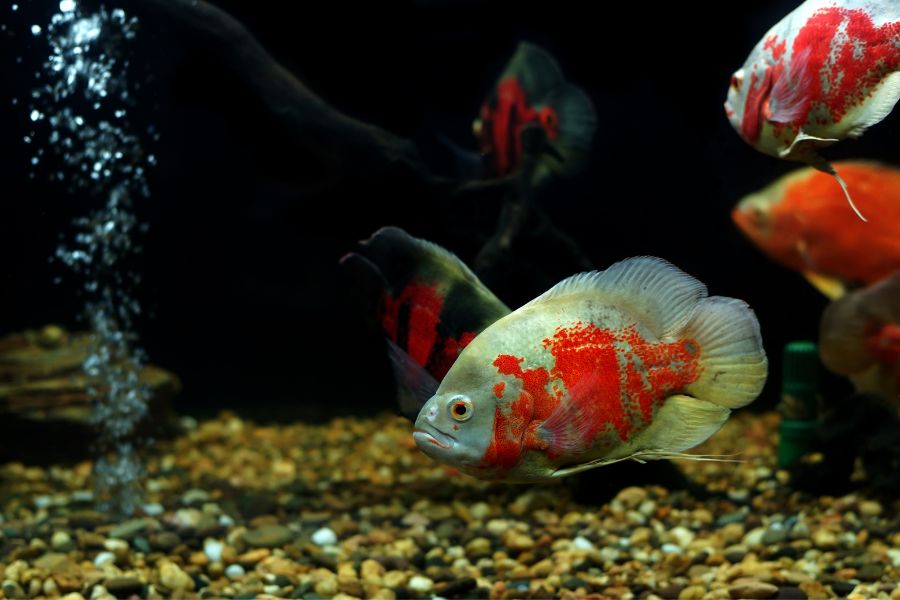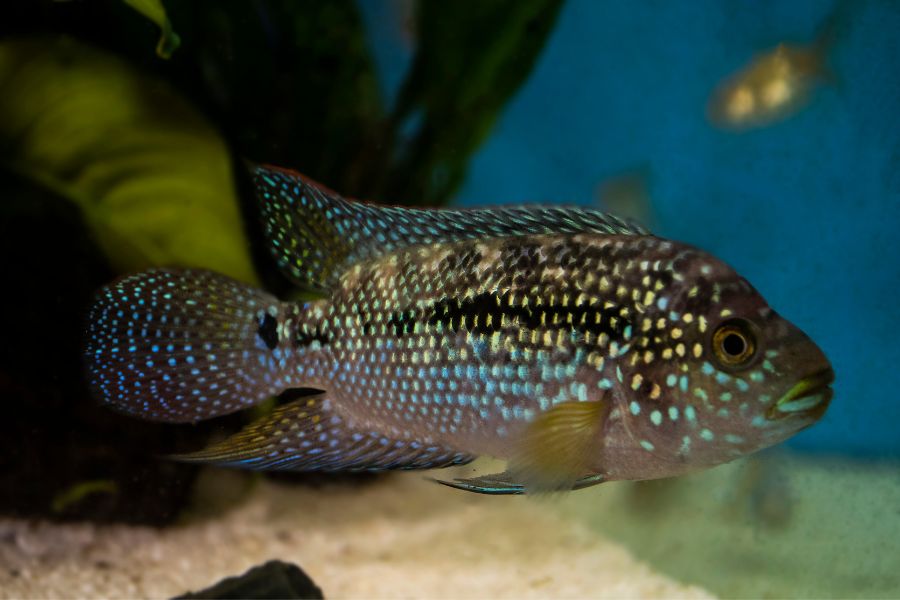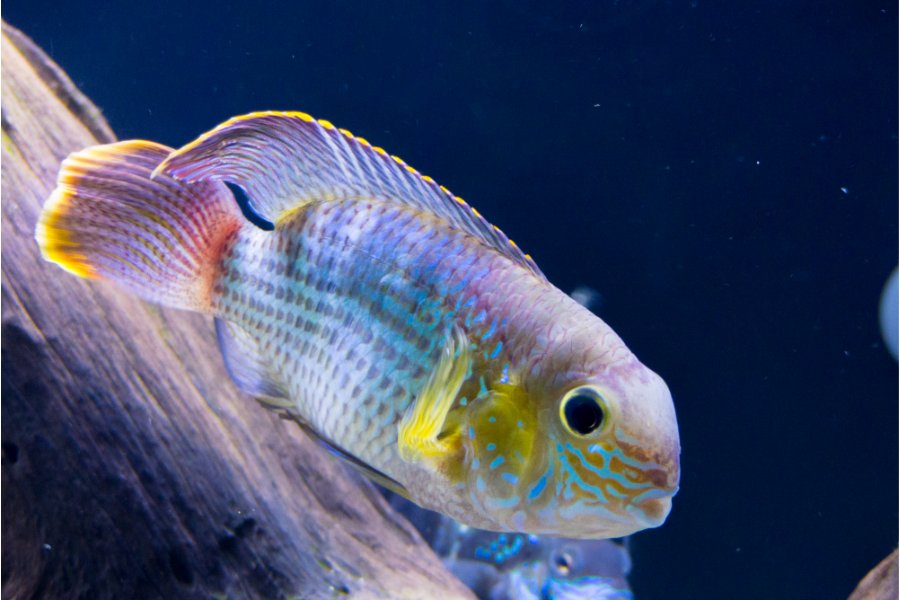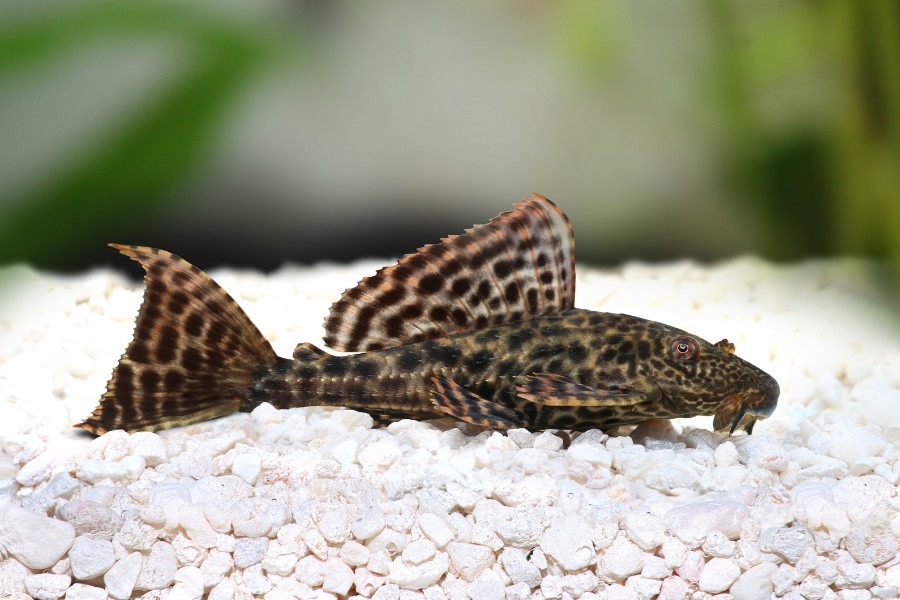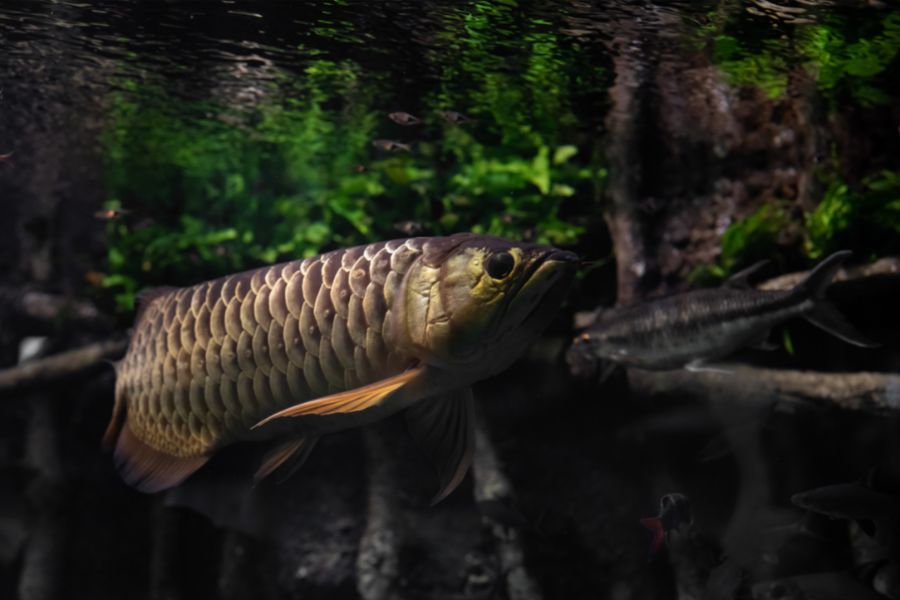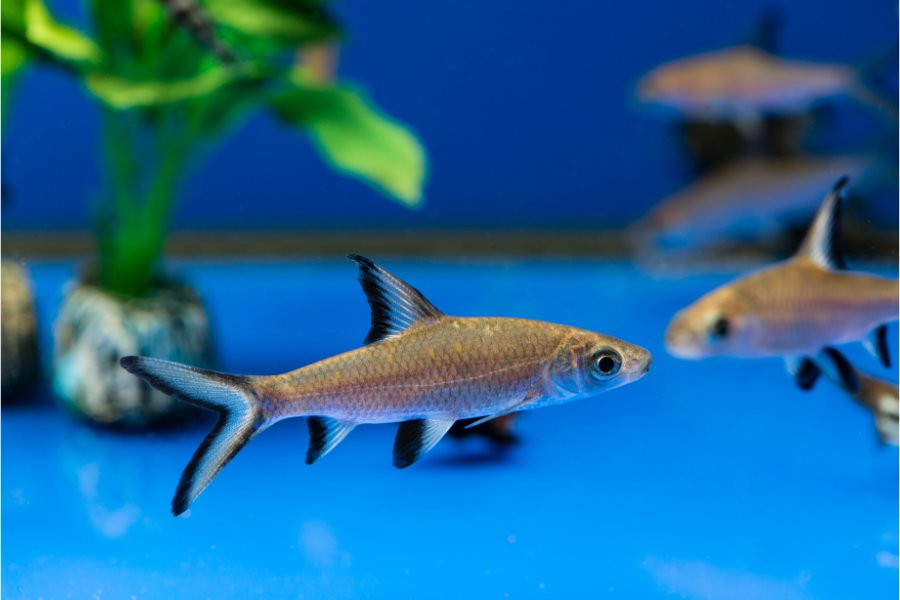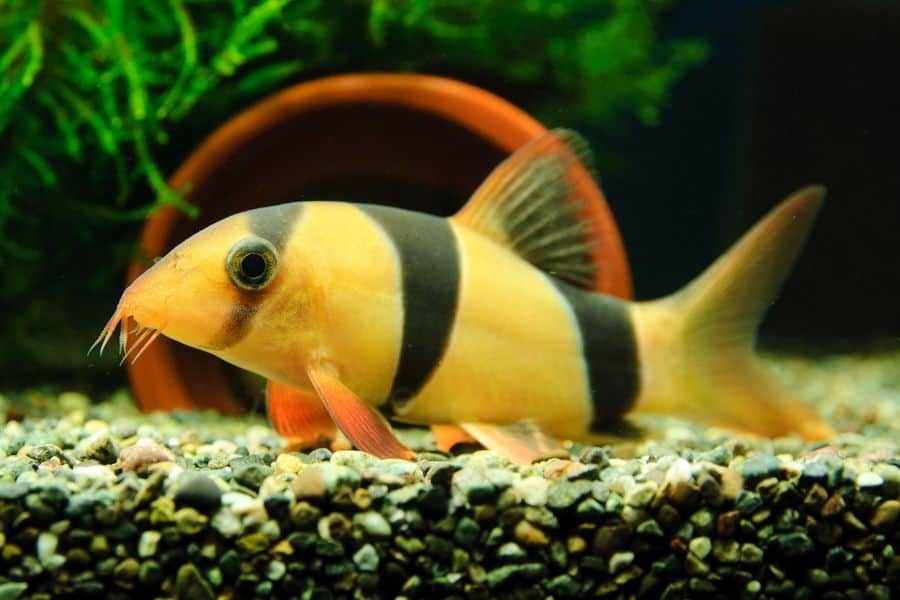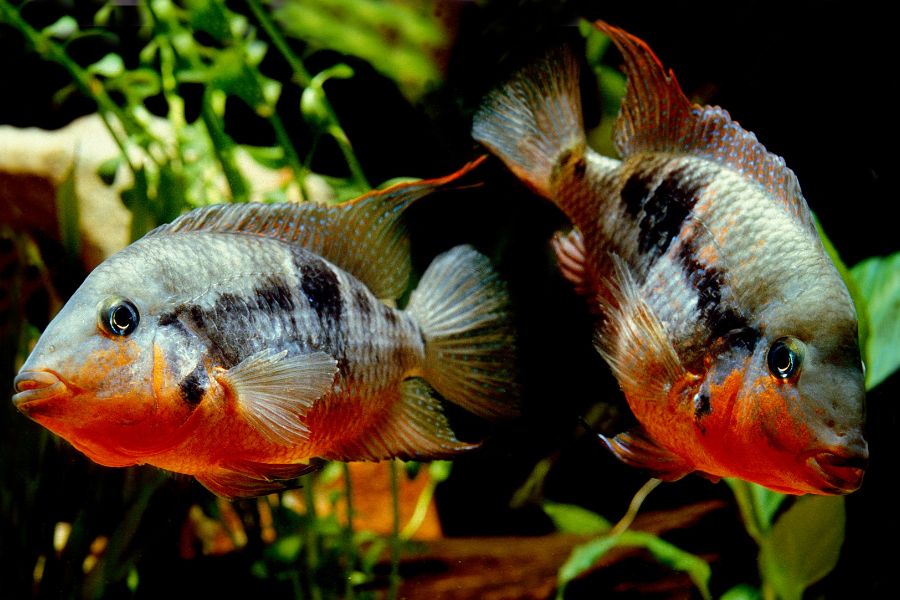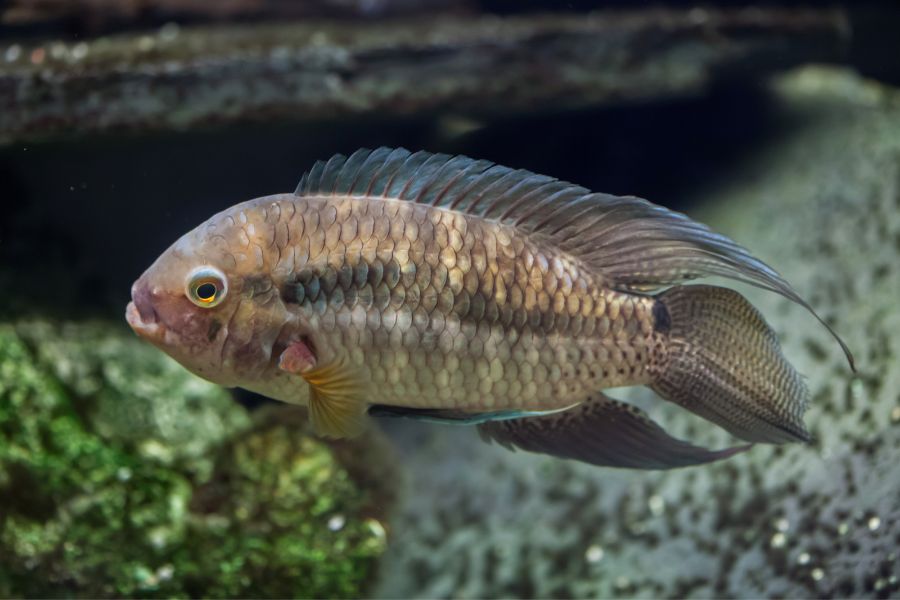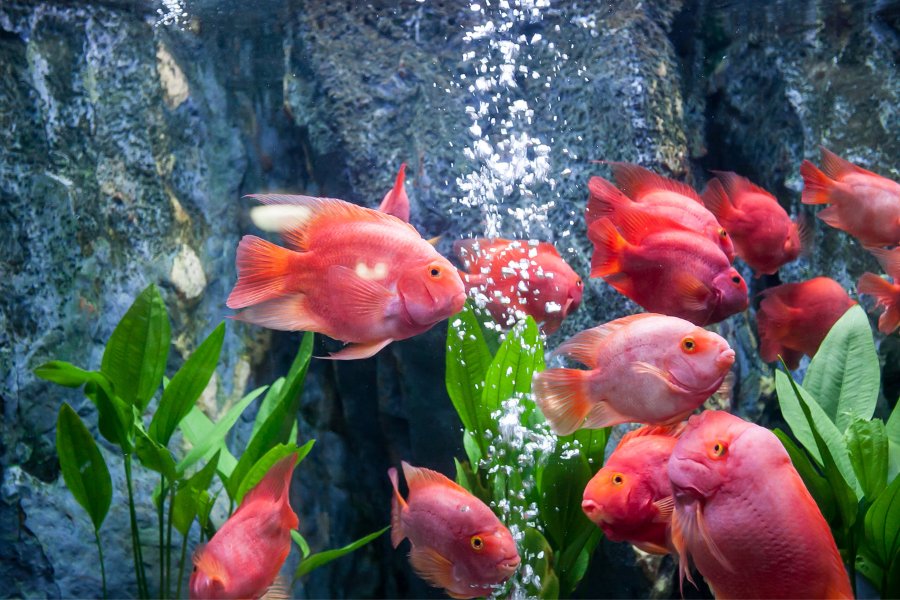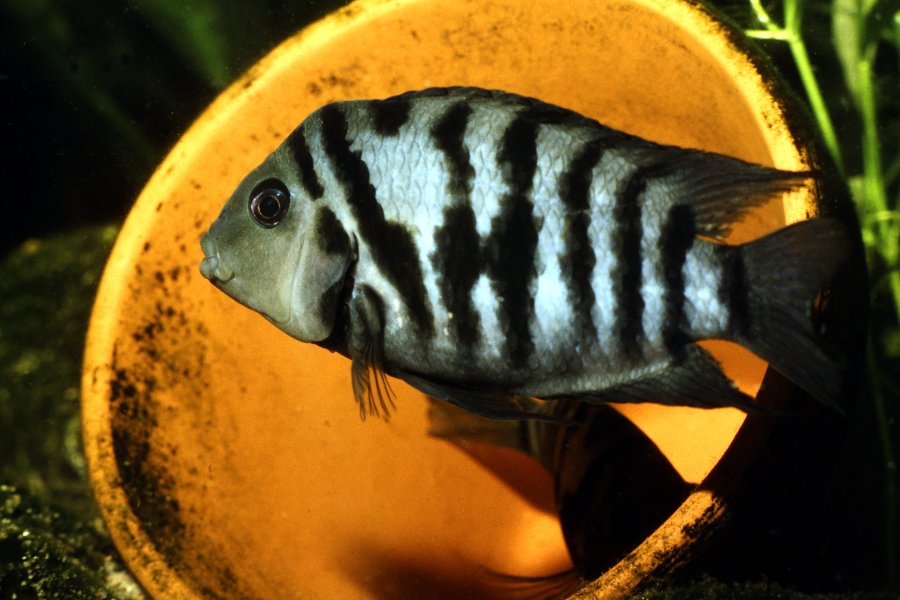Are you looking for the best mates for your Oscar?
Native to the Amazon Basin, South America, the Oscar fish (Astonotus ocellatus) is one of the most popular species of freshwater cichlid to keep in the aquarium.
Also known as the “water dog”, these fish stand out for their vibrant colors, unique personalities, and intelligence.
But before you get an Oscar, remember it can grow up to 12 inches in length and can live for as long as 15 years (with proper care).
Besides that, these species of cichlid are semi-aggressive. It’s crucial to select tank mates with the same temperament and size to ensure they get along.
Incompatible Oscar tank mates mean constant fights, injury, and sometimes death.
In this guide, we will highlight the best Oscar tank mates. Join us, and we will help you select a compatible mate for your pet.
Oscar Tank Mates Compatibility Considerations
Size
As mentioned in the introduction, Oscar fish can grow fairly large. In fact, it’s one of the fastest-growing fish, growing at a rate of 1 inch per month. They grow relatively quickly to survive in the wild.
In their natural habitat, Oscar can reach up to 16 or 18 inches. But, in captivity, they can only reach a maximum size of 12 inches (the size of an American football) or 14 inches.
Before introducing a new mate for your Oscar, ensure it’s at least 12 inches to avoid bullying and injury. Otherwise, the Oscar can eat the fish.
Temperament
Don’t let the beauty and good manners of Oscars fool you, they have quite a high temperament (aggressive or semi-aggressive).
These fish also have territorial tendencies. Oscars will attack any fish in the tank if they feel like their territory is being invaded. This makes it hard to keep them with other sea creatures.
Because of this, select a tank mate passive enough to avoid starting fights but strong to hold their own.
Water Parameters and Habitat Requirements
Oscars do not do well in cold waters. They prefer waters with temperatures between 78 to 82° F. Temperatures below 55° F can prove lethal to your pet.
As for water pH, they require water with pH levels of 6.5 and 7.5. However, some fish keepers say that a pH above 7 makes the fish susceptible to HITH (Hole in the Head) disease. Oscars also appreciate habitats with varied plant species and panty of hiding spots.
Therefore, choose a tank mate with the same water and habitat parameters as the Oscar to ensure both live comfortably.
Feeding Habits and Dietary Needs
The omnivores nature of Oscars allows them to feed on a range of meaty and vegetable-based foods. But remember, these fish also love preying on smaller or docile fish.
So, ensure the tank mates do not look or act tasty. They should also prefer a different type of food to avoid competition for food and starvation.
Best Oscar Tank Mates
Jack Dempsey
- Scientific Name: Rocio octofasciata
- Origin: Mexico
- Size: 10 to 15 inches
- Minimum Tank Size: 80 gallons
- Water Parameters: 72 to 86°F
- Care: Difficult
Jack Dempseys don’t make great candidates for community tanks since they’re very aggressive and territorial. But these characteristics make them the perfect tank mates for the Oscars.
Jack Dempseys grow large enough to avoid being on Oscar’s menu and bullying. In case of a fight, these tiny beasts can surely hold their own.
These fish are carnivores and usually prefer a diet of live worms, fish, and insects. That means you should provide them with enough food to avoid competition with the Oscars.
Because they can be territorial, ensure your tank features enough hiding spots and territory for both fish.
Green Terror
- Scientific Name: Andinoacara rivulatus
- Origin: Ecuador and Peru
- Size: 12 inches
- Minimum Tank Size: 75 gallons
- Water Parameters: 68 to 80°F
- Care: Easy and difficult (depending on experience)
Green Terror is not the fierce dragon in the House of the Dragon or the cute dragon in How to Train Your Dragon. It’s another handsome large cichlid with a huge fan base in the aquarium community.
Most fish keepers are drawn to this elegant fish because of its beautiful green or blue colors and patterns. But why does it make a good tank mate for the Oscars?
Well, Green Terror has the same water parameters and habitat requirements as Oscars. Sure, they are aggressive (especially females) but they will get along with your Oscar fish. As long as you provide both fish enough food and space to avoid a clash and fight.
Additionally, Green terrors and Oscars have similar diets and can eat a variety of vegetable and meat-based foods.
Plecostomus
- Scientific Name: Hypostomus plecostomus
- Origin: South America
- Size: 20 – 24 Inches
- Minimum Tank Size: 75 gallons
- Water Parameters: 72 to 82 °F
- Care: Easy
Plecostomus “folded mouth” is a peace-loving species of the Armored catfish species. These freshwaters fish come in a variety of colors and patterns and have elongated bodies, large curved fins, and four rows of bone plates.
They make excellent tank mates for Oscars since they complement their temperament and behaviors. They are peaceful and love spending their time at the bottom of the tank, eating excess food and algae. Therefore, they can help aquarists keep the tank and water clean.
Besides, Plecostomus can adapt to a wide range of water conditions, which makes them perfect to live in an Oscar tank.
However, they can be aggressive and territorial by chasing and pushing other fish around. This can happen due to stress, competition over food, and poor tank conditions.
Arowanas
- Scientific Name: Scleropages formosus (Asian Arowana), Osteoglossum bicirrhosum (Silver Arowana)
- Origin: Southeast Asia, Africa, South America
- Size: 48 inches
- Minimum Tank Size: 125 to 220 gallons
- Water Parameters: 78 to 85 °F
- Care: Intermediate to advance
Arowanas or Dragon fish are exceptional monster fish that inhabit a range of environments. They stand out because of their elongated bodies covered with scales and protruding pairs of barbels.
Some people also believe that these handsome fish bring good luck due to their resemblance to a traditional Chinese dragon.
Their large size and peaceful nature make them great companions for the Oscars. However, they require a large tank that can accommodate their size and consistent water conditions.
Yes, they are aggressive predators, but their temperaments and behavior complement that of the Oscars. Oscars and Arowanas also have the same water requirements and diet needs. That means maintaining both their health can be straightforward.
But remember, Arowanas can threaten smaller Oscars and may compete with them for food. For this reason, introduce this fish to the tank carefully.
Bala Shark
- Scientific Name: Balantiocheilos melanopterus
- Origin: Southeast Asia
- Size: 12 Inches
- Minimum Tank Size: 125–150 gallons
- Water Parameters: 72 to 82 °F
- Care: Easy
The Bala shark prefers a spacious aquarium and thrives in groups of 3 to 5. They also prefer clean and well-maintained environments.
As a tank mate, Bala sharks often avoid other fish unless it’s another Bala shark they can school together. They also avoid confrontation and never start a fight. And thanks to their large size, the Oscars will not think of attacking them.
In addition, they are fast swimmers and playful. As a result, they offer a pleasant contrast to the slow and deliberate movements of the Oscars. While they can’t offer you cuddles like cats and dogs, they will provide you with constant beauty and calming influence for up to 10 years.
Clown Loach
- Scientific Name: Chromobotia macracanthus
- Origin: Southeast Asia
- Size: 12 Inches
- Minimum Tank Size: 125 gallons
- Water Parameters: 72–82°F
- Care: Moderate or Intermediate
Native to Malaysia and Indonesia, the Clown Loach is a beautiful tropical fish. It is hard to resist taking this fish home because of its beautiful coloration, comprising a yellow-orange body, black stripes, and red fins. They also have unique whisker-like barbels.
Clown loaches love companions and prefer living in groups. So, ensure you get three or more. They are a peaceful fish species compatible with Oscars in terms of water parameters. Also, they are fast swimmers and can reach their food before the Oscars.
Another interesting fact is, these fish exhibit clown-like antics, like using clicking sounds to communicate, and sleeping by lying on their sides. Moreover, their playful behavior makes the tank lively.
Firemouth Cichlids
- Scientific Name: Thorichthys meek
- Origin: Central America
- Size: 7 Inches
- Minimum Tank Size: 50 gallons
- Water Parameters: 72 to 82
- Care: Easy
If you are looking to add another cichlid, we recommend the Firemouth Fish. It’s a brightly colored fish that makes a suitable mate and adds color to the tank.
Firemouth Cichlids have great adaptive skills and grow at a first rate. Most times, they are peaceful but can become semi-aggressive and territorial during spawning seasons.
In the tank, they love swimming in the mid-level layers, defending their territory, and foraging for food. Oscars prefer swimming around the upper level while hunting for food. Because of this, the two fish species can co-exist peacefully in the tank without interfering with each other.
But ensure you provide the Firemouth with lots of hiding spots and enough space so he can carve out his territory.
Cichlasoma
- Scientific Name: Cichlasoma trimaculatim, Cichlasoma amazornarum, etc
- Origin: Central and South America
- Size: 4–14 Inches
- Minimum Tanks Size: 55 gallons
- Water Parameters: 72 to 82°F
- Care: Easy
Cichlasoma refers to a group of fish in the cichlid family. These fish are hardy and can withstand a variety of water conditions. However, they still need a tank with a high-quality filtration system.
Like the Oscars, they have aggressive and territorial behaviors. But this is the reason they make great Oscar tank mates. They can hold their own against their aggressor, reducing the chances of bullying. Furthermore, they share the same water parameters.
If you wish to avoid or reduce aggression in the community tank, ensure there is enough room for both fish to swim freely and introduce plenty of hiding spots.
Blood Parrot Fish
- Scientific Name: Amphilophus citrinellus x Vieja synspilum
- Origin: Artificial Hybrid Species created in Taiwan
- Size: 6 – 10 Inches
- Minimum Tank Size: 55 gallons
- Water Parameters: 72 – 82°F
- Care: Moderate to Intermediate
Blood Parrot Fish is a hybrid aquarium fish species with an interesting look. It features a round body with a beak-like head and large eyes. These fish also have an impressive ability to co-exist peacefully with other tank companions, even Oscars.
Despite being hardy species, some hobbyists believe Blood Parrot Fish should not be bred and even exist. Because it’s a hybrid, the fish feature several traits that compromise their ability to live.
For instance, they have tiny mouths that prevent them from consuming enough food. Additionally, they are highly susceptible to disease and illness. Because of this, an effective tank filtration system is essential.
Nevertheless, they can hold their own against the Oscars and add unique coloration and activity to the aquarium.
Convict Cichlids
- Scientific Name: Amatitlainia nigrofasciata
- Origin: Central America
- Size: 4 -6 inches
- Minimum Tank Size:
- Water Parameters: 75 to 79
- Care: Moderate or Intermediate
Another Cichlid to consider is the Convict Cichlid or Zebra Cichlid. Characterized by stripe, this rowdy cowboy can live peacefully with your Oscar.
They might look small, but do not let their size fool you. These fish can hold their own against semi-aggressive Oscars. They are hardy and tough and can take on Oscars without getting overpowered or stressed.
Besides that, they share the same water parameters, including warm water with a pH level of 6.5 to 7.5 and a hardness scale of 10-20 dH. As for food, Convicts eat invertebrates in the tank and all sorts of vegetable and meat-based treats.
In addition, these fish are socially and generally peaceful. Nevertheless, they will require a lot of hiding spots and territory to reduce their aggression.
Worst Tank Mates for Oscars
- Small and delicate fish: Oscar is an aggressive predator and will prey on small, slow-moving fish. Avoid putting Oscar with small fish, like Guppies, Angelfish, and Neon Tetras. Even if the Oscar does not eat them, they may get bullied or injured by the Oscar.
- Fish with the same body shape and color: Oscars might become aggressive towards these fish and may fight.
- Shrimps: Oscars see small shrimps as food, so they might try to eat them.
- Aggressive fish: Avoid placing Oscars in the same tank with some breeds of aggressive cichlids, piranhas, and other fish. Otherwise, they might end up injuring or killing each other.
Read More:
FAQs
Can Oscars Co-Exist Peacefully with Other Cichlids?
Yes, Oscars can live peacefully with other species of cichlids, including Convict Cichlids, Firemouth Cichlids, Green Terror, Jaguar Cichlids, and Jewel Cichlids. However, ensure the selected species are not too aggressive or territorial.
Aside from that, monitor their behavior closely to avoid cases of bullying and injury.
Do Oscars Need Tank Mates?
Oscars can survive alone in a tank. But sometimes, they get aggressive towards their reflection or decoration in the tank. According to experts, Oscars should be kept in pairs or with other mates to provide them with social interaction and prevent aggression.
What Is the Minimum Tank Size for Oscars?
The ideal tank size for Oscars is 75 gallons since they grow pretty fast. They can reach a large size within a short period, provided they receive the right nutrition and water conditions. A larger tank ensures, Oscars have enough space to swim around and curve their territories.
Closing Thoughts
When selecting suitable Oscar tank mates, consider the temperament, size, and water requirements of potential companions, plus their dietary needs. The best tank mates for Oscars include Jack Dempsey, Green Terror, Plecostomus, and Arowanas.
Besides fish, you can include a few invertebrates like Nerite snails, Hermit crabs, and Crayfish. But it’s crucial to remember that Oscars are omnivores and might try to eat the invertebrates. As such, it’s wise to monitor the tank to ensure the safety of the invertebrates.
Additionally, research and observe potential Oscar tank mates before introducing them to the tank.
